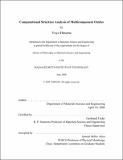Computational structure analysis of multicomponent oxides
Author(s)
Hinuma, Yoyo
DownloadFull printable version (5.005Mb)
Other Contributors
Massachusetts Institute of Technology. Dept. of Materials Science and Engineering.
Advisor
Gerbrand Ceder.
Terms of use
Metadata
Show full item recordAbstract
First principles density functional theory (DFT) energy calculations combined with the cluster expansion and Monte Carlo techniques are used to understand the cation ordering patterns of multicomponent oxides. Specifically, the lithium ion battery cation material LiNi0.5Mn0.5O2 and the thermoelectric material P2-NaxCoO2 (0.5 =/< x =/< 1) are investigated in the course of this research. It is found that at low temperature the thermodynamically stable state of LiNi0.5Mn0.5O2 has almost no Li/Ni disorder between the Li-rich and transition metal-rich (TM) layer, making it most suitable for battery applications. Heating the material above ~600°C causes an irreversible transformation, which yields a phase with 10~12% Li/Ni disorder and partial disorder of cations in the TM layer. Phase diagrams for the NaxCoO2 system were derived from the results of calculations making use of both the Generalized Gradient Approximation (GGA) to DFT and GGA with Hubbard U correction (GGA+U). This enabled us to study how hole localization, or delocalization, on Co affects the ground states and order-disorder transition temperatures of the system. Comparison of ground states, c lattice parameter and Na1/Na2 ratio with experimental observations suggest that results from the GGA, in which the holes are delocalized, matches the experimental results better for 0.5 =/< x =/< 0.8. We also present several methodological improvements to the cluster expansions. An approach to limit phase space and methods to deal with multicomponent charge balance constrained open systems while including both weak, long-range electrostatic interactions and strong, short-range interactions in a single cluster expansion.
Description
Thesis (Ph. D.)--Massachusetts Institute of Technology, Dept. of Materials Science and Engineering, 2008. This electronic version was submitted by the student author. The certified thesis is available in the Institute Archives and Special Collections. Includes bibliographical references.
Date issued
2008Department
Massachusetts Institute of Technology. Department of Materials Science and EngineeringPublisher
Massachusetts Institute of Technology
Keywords
Materials Science and Engineering.